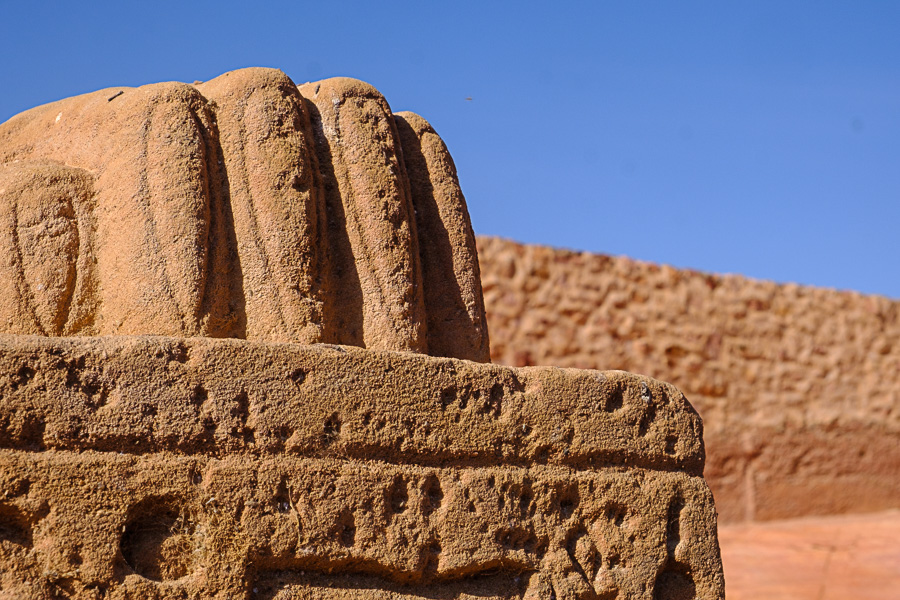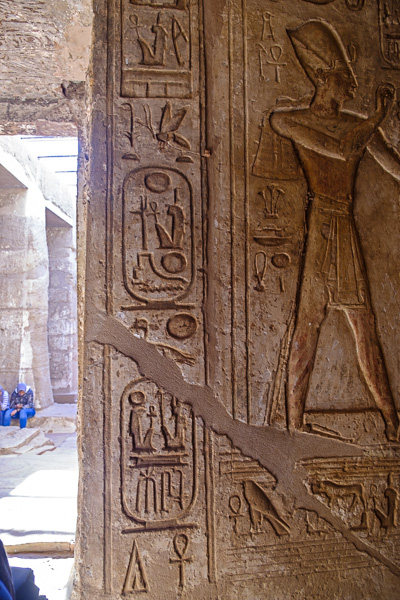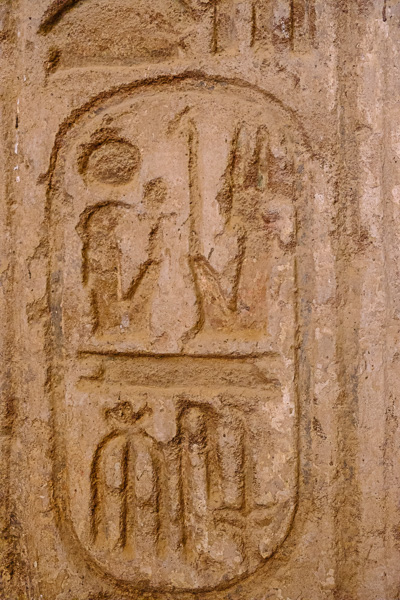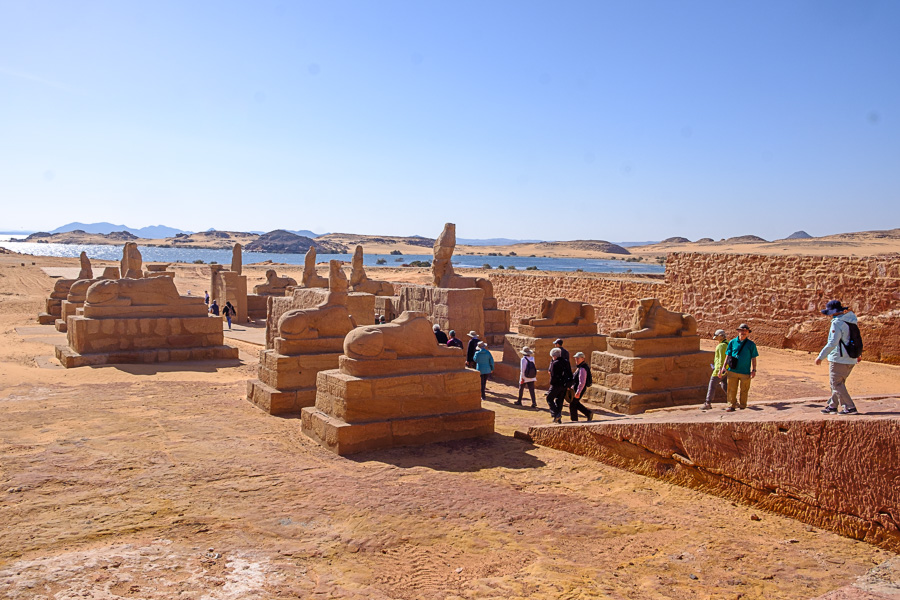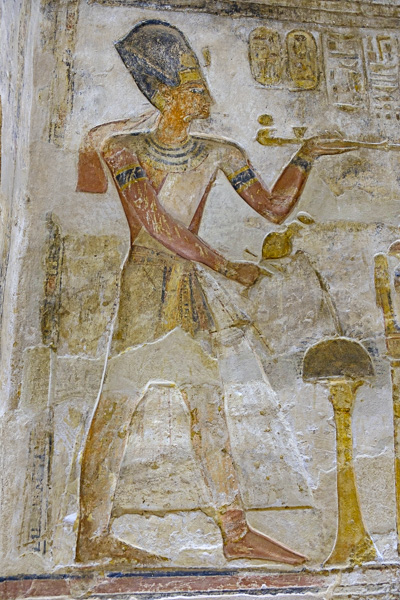That guy Ramses II knew how to build a temple and his artists and builders knew how to stroke his ego and build his brand. He lived to 91 years of age and ruled at the peak of Egypt’s last pharaonic age, the New Kingdom.
Egypt had three kingdoms: Old, Middle and New Kingdoms stretching from the beginning of recorded history (3200 BCE, give or take) until Alex the Great conquered the place in 392 BCE. The times between the kingdoms were times of turmoil and uncertainty. Egypt was largely isolated from the outside world during the Old and Middle Kingdoms. Egyptians did trade with foreigners and fought the occasional war but the cataracts to the south, the Mediterranean to the north and the deserts and mountains to the east and west kept foreigners out and Egyptians in.
Technology, in the form of horse and chariot, disrupted that isolation. Improved transportation made travel across the deserts and around the cataracts. The Hisoks from present day Israel and Syria invaded using horses and chariots during the Intermediate period between the Middle and New kingdoms, upsetting the Egyptian apple cart during their brief (70 year) stay as rulers of Egypt. But during the New Kingdom, Egyptian pharaohs, including Ramses II, made Egypt a world power. They extended Egypt’s rule to include Nubia, where we are today and other parts of North Aftrica and the eastern Mediterranean kingdoms.
This morning we visited the shores of Lake Nasser to see three temples relocated to this spot from areas now submerged beneath lake level. Of the three, one dates from the time of Ramses II, one from the Grecian period and the other from the late Roman period. Of the three, Ramses II’s temple is the real standout.
Wadi Al-Seboa Temple, circa 1200 BCE, features Ramses II mixing it up with gods and goddesses to prove that he is blessed by and an equal to them. It is finely decorated and well preserved. Hatem showed us the kartuses that spell out Ramses II’s birth name and coronation name.
Hakem said that here in Nubia Ramses II was able to claim that he had, as a pharaoh, actually become a god himself. He couldn’t make that claim back at headquarters in Themes; the priesthood there was too strong to allow him to elevate himself to raise himself to the level of the one true god.
Dakka Temple dates from the Grecian era (200 BCE). It too depicts the pharaoh being blessed by the gods and goddesses. Unfortunately, the kartushs giving the kings name spell out only “pharaoh” as if everyone knows who the current pharaoh is.
Hatem has offered to spell our names as a kartush and Arabic too if we wish. We can purchase a kartush in the gift shop ensconced in gold or silver to take home as a souvenir.
Dakka Temple shows clear signs of Christian occupation. In the inner sanctum, the pharaoh’s statue normally stands with statues for the gods (e.g., Horus) on either side. The statues in this temple have been removed and in the place of the pharaoh’s statue an image of what is identified in Greek lettering as St. Peter has been sketched, receiving the adulation of the Egyptian deities. Elsewhere French graffiti, including the date “1828” mar the surface of the walls.
The third temple, Maharraqa, is from the late Roman period, perhaps 300 – 400 CE. It’s unfinished and rather plain. At that time the Roman ruler of Egypt, who had declared himself pharaoh, had ordered the temple constructed but must have run out of money or slaves or will power to complete it.
Hatem said we wouldn’t bother with Maharraqa Temple except it was on the way to the pickup spot where the boat would return us to the ship. What he didn’t tell us was that in front of the temple was a man with a living two-foot-long crocodile, fresh from the waters of Lake Nasser. See the picture of me making nice with the croc. That’s a string you’ll see tied around the poor crocodile’s snout. Crocodiles can’t survive modernity, including high-speed turbine blades, so they are no longer found in the Nile but thrive in the lake.
Back on board the ship we were treated to a ship’s tour, starting with the kitchen. Each cook showed off his bailiwick (salad prep, pastries, ovens, etc.) with great pride and humor. They took special care to describe the elaborate water filtration and chemical treatment processes they take to ensure that the salads we eat are perfectly safe. I say “we” but exclude Judy and me. The rewards of eating greens are greatly overshadowed, for us, by the risk, no matter how remote, of La Touristica.
They showed us the luxury suites (unoccupied on this voyage). Nice, but who would spend extra bucks when the real action is on shore? Finally, the bridge, where our captain sat in a throne-like chair steering us down the lake. He said that the worst weather comes in the spring when strong winds blow across the desert from the west, obscuring vision and making for rough water.
A break for a rest and lunch, we’re back in the boat off to see more. Again, three sites that have been moved from what is now the lakebed to dry land: two temples and a burial chamber.
The Amada Temple was constructed in the New Kingdom under Pharaoh Thutmose. He preceded Ramses II. By conquering Nubia and Kush, Thutmose established the economic wealth (e.g., gold) that flowed from that region and elsewhere, giving Ramses and others in the New Kingdom the wherewithal to build all the temples we’ve been seeing.
I wish I could retell the stories that are depicted in the many wall carvings we saw today and yesterday. Hatem has given us blow-by-blow descriptions of many and they are fascinating. They deal with the Pharaoh giving tribute to the gods and the gods extending protection and long life to the pharaoh. Others tell stories that establish the power of the pharaoh to reward those loyal to him and to punish his enemies. There are strong parallels to present-day political ads we see on TV: “Vote for me and I will reward you if you do I will punish our enemies and I’m blessed by God to do this work.”
Elderr Temple belongs to Ramses II and is distinguished by the well-preserved wall carving stories that retain much of their original coloring. Hakem pointed out that each color had a significance. Blue, the color of the Nile; black, the color of the silt that the Nile deposited, making crops grow, and so on.
Incidentally, the Nile dams regulate the flow of water so as to avoid disruptive flooding in the springtime. But the dams cut off the flow of silt that used to regenerate the soil each spring. Not to worry; chemical fertilizers can make up for the natural nutrients the floods used to bring.
Finally, a burial tomb for an unknown, probably rich person but one who was not of royalty. Wall stories depicted mourners, dressed in white, including a troop of professional mourners hired to fill in for less than mournful relatives, I guess.
The afternoon wouldn’t be complete without another wildlife encounter. Sure enough, outside the burial chamber was a guy with his pet scorpion and an asp, like Cleopatra’s friend, safely housed in a glass jar. Pictures of Doug and me with the scorpion are included.
Back on board we were scheduled to view a video in one of the ship’s lounges. The computer wouldn’t talk to the projector, so they ended up showing it over the TV system. Most of what I saw (between eye rests) was quite interesting. It dealt with the procedures and equipment used to move the temples from their original position to their new above water sites. Much of the work was manual, including the sawing of the stonework into pieces for transport.
Then dinner and what was supposed to be some sort of party involving traditional Nubian dress. Maybe we, along with others of our group, were in the wrong location but it never happened.
Tomorrow is our last full day on the lake and in Nubia territory. The Nile river cruise is next.
















